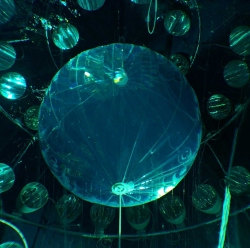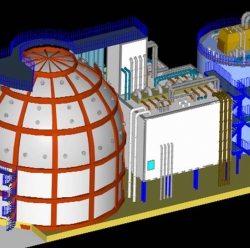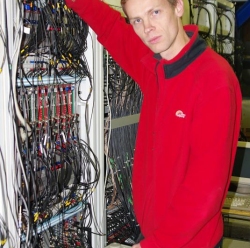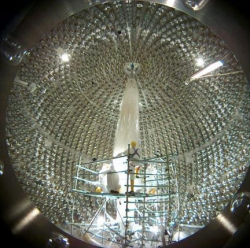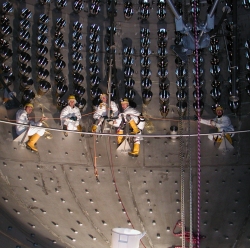More about Borexino experiment
Borexino mega-project which is carried out by the collaboration of several European countries, Russia and USA in the Gran Sasso underground laboratory (Italy), aims to perform basic researches in the fields of neutrino and particle physics as well as interdisciplinary studies for solving the mainstream tasks of the astrophysics, atomic industry, geo-sciences. It is more then one hundred physicists from the leading scientific centers which participate in the Borexino. From the Russian research institutes the responsible organization is National Research Center “Kurchatov Institute”.
Borexino is a multipurpose scintillation (anti)neutrino detector with the target mass of 300 t. Data-taking has started in 2007 and is currently ongoing. The main goal of the experiment is the study of the solar electron neutrinos flux in the low energy region (lower than 1 MeV). Electron neutrinos are detected through their scattering off electrons of the scintillator’s atoms. Major feature of the detector is an unprecedentedly high radiopurity of the scintillator and detector’s materials. Thanks to that, the energy threshold for the neutrino detections is as low as 100 keV.
The following global impact results were obtained with the Borexino:
- Fluxes of the solar 7Be and pep-neutrinos have been measured for the first time in a real time mode; neutrino oscillations parameters have been measured;
- Solar 8B neutrino flux has been measured; neutrino oscillations in matter confirmed;
- Geo-neutrino flux has been measured; contribution of the radiogenic part into the Earth’s heat balance was studied; record constraints on possible existence of the geo-reactor in the Earth’s core were set;
- Record constraints on existence of physical effects beyond the Standard model were obtained (nucleon instability, neutrino magnetic moment, neutrino stability and others);
- Record constraints on existence of physical effects beyond the Standard model were obtained (nucleon instability, neutrino magnetic moment, neutrino stability and others);
- New experimental limits on the Pauli-forbidden transitions were set;
- Limits on the solar and other unknown anti-neutrino fluxes as well as solar axions were set with the record accuracy.
Borexino is equipped with an auxiliary, independent data-taking system based on Fast WaveForm Digitizers (FWFD). It was implemented by Kurchatov Institute experts to extend the range of the spectroscopic measurements by Borexino into the inaccessible for the main electronics area up to ~60 MeV. The system allows solving the following tasks:
- Scintillation events spectrometry in the energy range of 1 - 60 MeV;
- Digitization of the scintillation pulse shapes;
- Splitting the multi-cluster events close one to other in time.
Thanks to implementation of this Russian project in the Borexino, the detector becomes unique in its studies of not only neutrinos from the Sun and terrestrial sources, but from the galactic and extragalactic neutrino sources as well (Supernovas, Gamma-ray Bursts, primordial black holes clusters and others).
Contact Person:
Skorohvatov Mikhail




